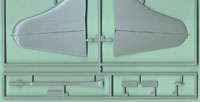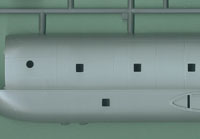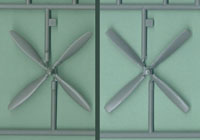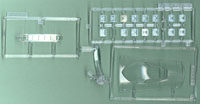


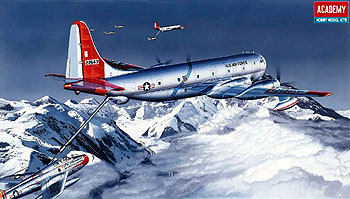 Academy's
1/72
Academy's
1/72
KC-97G
By Chris Banyai-Riepl
History
The origins of the Boeing model 367/C/KC-97 go clear back to January, 1942. The then USAAF ordered three prototypes of a cargo version of the B-29. Since the B-29 had not even flown yet, and would not until September of that year, it is easy to see that Uncle Sam was desperate for large capacity cargo airplanes to feed the war. The C-97 did not benefit from the high wartime production priority that the B-29 had, however. Thus first flight did not occur until November, 1944. None of the three XC-97s saw wartime service, but were used for test work. The initial testing was favorable enough to win a contract for ten service test YC-97s in July, 1945. Three of those ten were YC-97As and bear the exact same relationship to the YC-97 as the B-50 bore to the B-29; new lighter aluminum structure and new nacelles with the P & W 4360 engines. Thus was born the Stratocruiser we recognize today.
The YC-97A success resulted in a production order for fifty C-97As. As always, there were some differences between the YC and C birds. For us modelers they include the replacement of the Curtiss props with Hamilton Standards, and from the 28th bird on, the chin radome. Also a cargo door was added to the starboard forward fuselage. Oh yeah, and those pesky square windows that make it difficult to use your 377 model as a military transport.
Three of these C-97As were pulled off the production line and the Boeing flying boom refueling system developed on the KB-29, was incorporated. The KB-29 just could not keep up with the new SAC B-50s then in service, and the forthcoming jet bombers would be impossible to refuel with the KB-29. The resulting KC-97E was the start of a long run of Boeing Tankers. The mating of the boom to the airframe was almost as simple as removing the cargo doors in the aft fuselage and plugging in the pod/boom system. Of course nothing concerning airplanes and the military ever stays simple, so the changes began, but in overall appearance, the KC-97 was here.
The 367 Stratocruiser was not a huge commercial success, only 55 were ever built, but the cargo airplanes and tankers rolled off the Renton line for a long time. It has been said that this program provided Boeing with the facilities and finances to gamble on the later commercial jetliner that we all know- the 707 series. Also, it provided a proven aerial refueling system when it came time to sell the USAF on the next tanker-the KC-135.
The KitThis is Academy's third release of their Boeing 377 series of models and it's probably the most anticipated release yet. On the tops of many people's most wanted list, the KC-97 looks to be a great build. Like the 377 and C-97A kits, this kit uses some common sprues from the Academy B-50 kit. Likewise, there are common parts between the 377 and the KC-97, with the only new additions being the boom parts.Another change from the 377 is the windows. On the 377 kit the windows are round, while on this kit the windows are square. Other than this small change the rest of the fuselage and interior remains the same as that for the 377 and the C-97A kits, namely a complete (albeit basic) front cabin and nothing in back. While this isn't a problem with the 377 or C-97A, with the KC-97 there is a rather large opening in back with some good-sized clear panels for the boom operator. Nothing is provided to blank this area off, leaving the possibility of seeing all the way through from the boom operator's position to any of the side windows. While not much can be seen through this area, it would have been nice if Academy had provided at least something to go back there.While we're on the subject of the tail, there's a couple things that caught my eye. First off, Academy has decided to engineer the entire separate tail section as a clear piece. This results in something similar in arrangement to the nose piece in that you can fair it in without having to worry about gaps around the clear areas. The boom looks to be accurate in shape, but it's missing any representation of the actual refueling point. The boom just ends as a flat piece, rather than a hollow hole with the retracted refueling part showing. This might be difficult to fix, although it might work out just cutting off the tip and adding a section of plastic tube with an appropriate representation of the retracted part in it. |
Another nice touch by Academy is the inclusion of the under-fuselage lights as a clear piece. This should really add some realism, especially for those enterprising souls who decide to light them up with LEDs or something.
The decals are, in a word, HUGE! The sheet was almost too big to fit on my legal-sized scanner! Lots and lots of stencils, walkway markings and data blocks on this sheet, with the rest being the SAC bands, stars-n-bars, and USAF with a silver outline. The decals are in register and look to be pretty good.
Conclusion
This is the kit everyone has been waiting for, and now that it's out I'll bet that there will be some people waiting for the next one. Next one? Well, I sure hope so, as this kit did not include the jet engines that were seen on the KC-97Ls and on some Gs. Rumor has it that Academy will be releasing an L with the jets, but this hasn't been confirmed. If they don't, I'm sure it won't take a resin company too long to release a set, though, and with companies like Airway Graphics planning a slew of decal sheets for the bird, the trio of Academy 377 kits are very welcome indeed.
For the Internet Modeler review of the Boeing 377, click here.
For the Internet Modeler review of the C-97A, click here.

Previous: Contents


